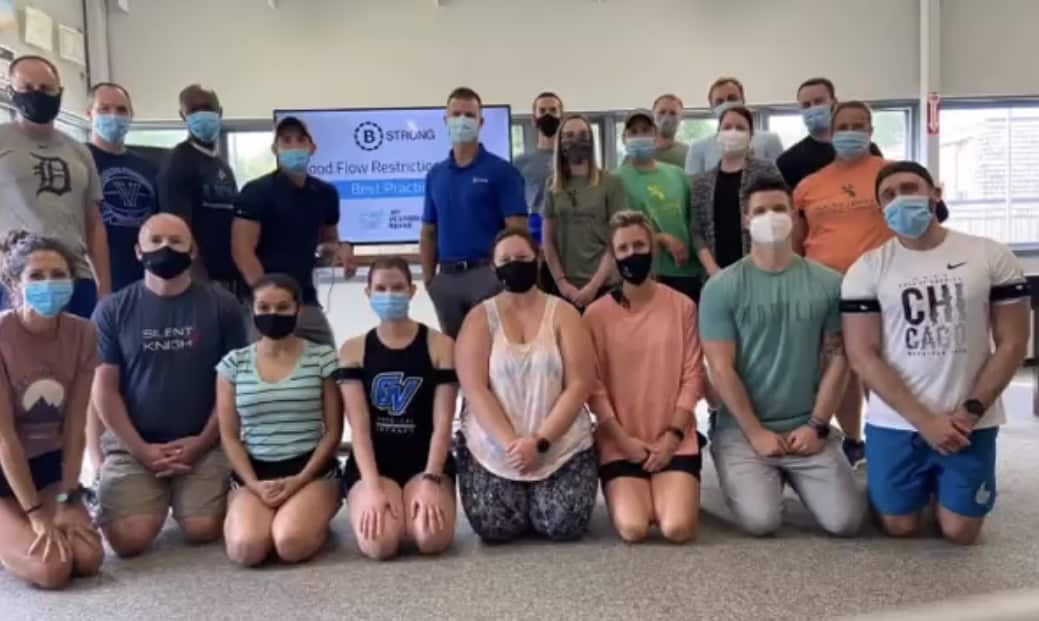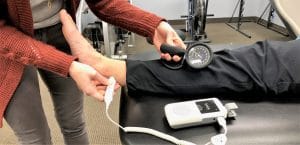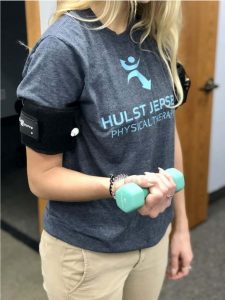What is Blood Flow Restriction?

One of the things I love about working at Hulst Jepsen Physical Therapy is the importance we place on continuing education. We strive to be an evidence-based profession and company. It is so important to us, that we invest in unlimited continuing education for all of our employees. Last summer, several of our clinicians were able to take a course on blood flow restriction training, and I can say, this has been the most useful con-ed class I have taken so far. I have seen tremendous success with many different patients, especially athletes. This includes improved function, strength, stability, trust in the body, confidence, and most importantly, significant decreases in pain, AND at a quicker rate than traditional exercise.
So, what is Blood Flow Restriction (BFR) training?
 BFR is a technique that involves exercising with an inflatable cuff around the arm or leg. The cuff is designed to reduce blood flow and subsequently oxygen saturation within the limb, but not cut it off completely. This allows us to train the muscle to fatigue and appropriately load tendons without over-straining the muscles, tendons, surgical repairs, or other injured tissue nearby. It has also been found to cause systemic effects such as the release of growth hormone which also helps soft tissues build and muscle repair.
BFR is a technique that involves exercising with an inflatable cuff around the arm or leg. The cuff is designed to reduce blood flow and subsequently oxygen saturation within the limb, but not cut it off completely. This allows us to train the muscle to fatigue and appropriately load tendons without over-straining the muscles, tendons, surgical repairs, or other injured tissue nearby. It has also been found to cause systemic effects such as the release of growth hormone which also helps soft tissues build and muscle repair.
What’s a BFR session like?
There are many variations for BFR, but the typical session consists of 10-30 minutes (depending on the level of training and time after surgery, among other factors) of low-intensity exercises with high reps. My go-to is 1 set of 30 reps followed by 3 sets of 15 reps of each exercise. 75 reps is a lot…. However, the individual works out at 30% of their maximum capacity which is similar to endurance training. HOWEVER, and this is the most important part… Research has shown the effects of BFR with low resistance and high repetition protocols are very similar to the improvements seen with high-level resistance/ power training (low rep/high weight), but with less overall pain after training.

Although there are many applications for BFR, I will mostly use it for tendonitis and post-surgical patients. Tendonitis is usually caused by repetitive activities in which the muscles and tendons are not able to tolerate the strain placed on them. The muscles and tendons need to get stronger and more resilient. BFR allows the patient to train the muscle and tendon without over-straining the injured regions of the tendon. My favorite application for BFR is post-surgical. We can start shortly after surgery, fatigue the muscle, and start building it back much quicker than traditional PT. A big complaint from people who have knee surgeries is the quick loss of muscle and how much smaller the surgical leg looks. BFR helps combat this and prevents muscle atrophy right away, which is followed by much quicker muscle building and subsequently a quicker recovery.
Why is this important and who can benefit?
Again, we can train the tissue in a safe range and level while still building muscle strength, tendon thickness, and overall tissue resilience. I realize that I have talked a lot about muscle training and building, yet most patients are coming to physical therapy because they are in pain. Well, a huge part of recovery IS about building back strength and tissue resilience. This is what typically helps patients heal and takes away their pain. Simply put, the more patients can exercise and move safely while limiting pain, will ultimately eliminate pain.
Are you in pain but not sure how to manage it? Call 616-256-8679 or visit https://www.hjphysicaltherapy.com/request-appointment/ to schedule your FREE consultation today and learn how physical therapy could help you. For more information please visit any of our Hulst Jepsen Physical Therapy locations or check out our website at www.hjphysicaltherapy.com.
